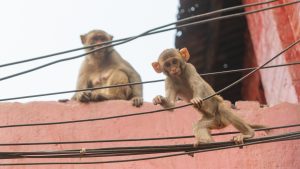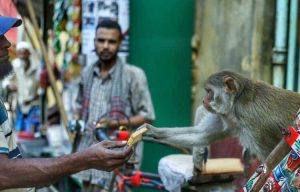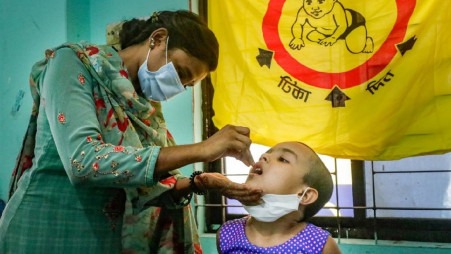From Rooftops to Ruins: The Vanishing Monkeys of Dhaka

- Update Time : Thursday, May 22, 2025

Summary
The decline of rhesus macaques in Dhaka began in the late 20th century
The migration of Hindu families, who traditionally cared for these monkeys, reduced the human support they once relied upon
Need for community-based initiatives to ensure the coexistence of humans and monkeys in Dhaka’s urban landscape
Monkeys, particularly rhesus macaques (Macaca mulatta), have been an integral part of Dhaka’s urban ecosystem for over a century. Their presence, especially in areas like Gandaria in Old Dhaka, was once a common sight, with these primates coexisting alongside human residents.

Historical Presence (1950s–1970s)
In the mid-20th century, rhesus macaques thrived in Dhaka, particularly in neighborhoods with abundant greenery and fruit-bearing trees. Many Hindu households revered these monkeys, feeding them and allowing them to inhabit gardens and rooftops. A 1976 study recorded 11 troops totaling 196 individuals in Old Dhaka, which increased to 220 after the birth season that year. By 1983, the population was noted at 229 across 11 troops.
Decline in Population
The decline of rhesus macaques in Dhaka began in the late 20th century, primarily due to rapid urbanization. The transformation of low-rise buildings and gardens into high-rise structures led to significant habitat loss. Additionallty, the migration of Hindu families, who traditionally cared for these monkeys, reduced the human support they once relied upon. By 2005, a survey recorded only 178 monkeys across 10 troops in Old Dhaka, indicating a notable decrease.

Current Status
Today, the rhesus macaque population in Dhaka is confined to a few pockets, with the most notable group residing within the premises of Sadhana Aushadhalaya in Gandaria. This Ayurvedic factory, established in 1914, has become a sanctuary for these monkeys, where employees continue to feed and shelter them, honoring the founder’s legacy.
Despite these efforts, the overall monkey population in Dhaka remains vulnerable. Incidents of harassment by locals, such as stone-throwing, have been reported, and the scarcity of food sources has made survival challenging for these primates. While the Wildlife (Conservation and Security) Act of 2012 offers legal protection, enforcement is limited. Conservationists emphasize the need for community-based initiatives to ensure the coexistence of humans and monkeys in Dhaka’s urban landscape.

In summary, while rhesus macaques were once a vibrant part of Dhaka’s urban environment, their numbers have dwindled due to habitat loss and reduced human support. Conservation efforts, both legal and community-driven, are essential to preserve the remaining populations and maintain the ecological balance in the city.










Leave a Reply